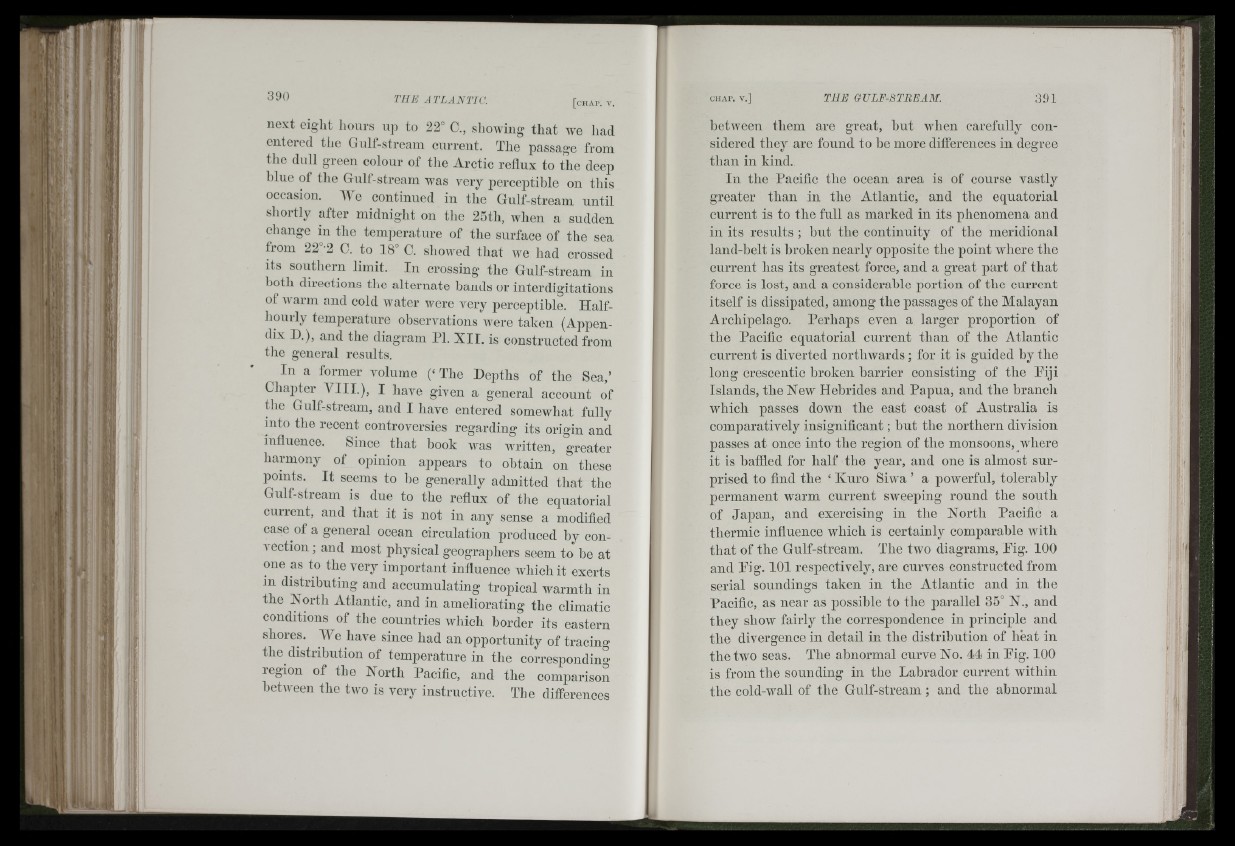
.» -'T- '
next eight hours up to 22° C., showing th a t Ave had
entered the Gull-streain current. The passage from
the dull green colour of the Arctic reflux to the deep
blue of tlie Gulf-stream Avas A'ery perceptible on this
occasion. We continued in the Gulf-stream until
shortly after midnight on the 25th, when a sudden
cliange in the temperature of the surface of the sea
tioni 22 2 C. to 18 C. showed th at aa'c had crossed
its southern limit. In crossing the Gulf-stream in
both directions the alternate bands or interdigitations
of Avarm aud cold Avater were very perceptible. Half-
liourly temperature observations Avere taken (Appendix
D.), and the diagram PI. X II. is constructed from
tlie general results.
In a former volume (‘ The Depths of the Sea,’
Chapter V III.), I have given a general account of
Die Gulf-stream, and I have entered somewhat fully
into the recent controversies regarding its origin and
influence. Since th at hook was written, greater
hannony of opinion appears to obtain on these
points. I t seems to lie generally admitted th a t the
Gulf-stream is due to the reflux of the equatorial
current, and th at it is not in any sense a modified
case of a general ocean circulation produced hy convection
; and most physical geographers seem to be at
one as to the very important influence Avhich it exerts
in distributing and accumulating tropical warmth in
the North Atlantic, and in ameliorating the climatic
conditions of tlie countries which border its eastern
shores. We have since had an opportunity of tracing
the distribution of temperature in the correspondino-
region of the North Pacific, and the comparison
hetween the two is very instructive. The differences
hetAveen them are great, hut Avhen carefully considered
they are found to he more differences in degree
than in kind.
In the Pacific the ocean area is of course vastly
greater than in the Atlantic, and the equatorial
current is to the full as marked in its phenomena and
in its results ; but the continuity of the meridional
land-helt is broken nearly opposite the point Avhere the
current has its greatest force, and a great part of th a t
force is lost, and a considerable portion of the enrrent
itself is dissipated, among the passages of the Malayan
Archipelago. Perhaps even a larger proportion of
the Pacific equatorial current than of the Atlantic
current is diverted nortliAvards; for it is guided by the
long crescentic broken harrier consisting of the Piji
Islands, the New Hebrides and Papua, and the brancli
which passes down the east coast of Australia is
comparatively insignificant; h u t the northern division
passes at once into the region of the monsoons, where
it is bafiied for half the year, and one is almost surprised
to find the ‘ Kuro SiAva ’ a powerful, tolerably
permanent warm current SAveeping round the south
of Japan, and exercising in the North Pacific a
thermic influence which is certainly comparable with
th a t of the Gulf-stream. The two diagrams. Pig. 100
and Pig. 101 respectively, are curves constructed from
serial soundings taken in the Atlantic and in the
Pacific, as near as possible to the parallel 35° N., and
they shoAV fairly the correspondence in principle and
the divergence in detail in the distribution of heat in
the two seas. The abnormal curve No. 44 in Pig. 100
is from the sounding in the Labrador current Avithin
the cold-Avall of the Gulf-stream ; and the abnormal